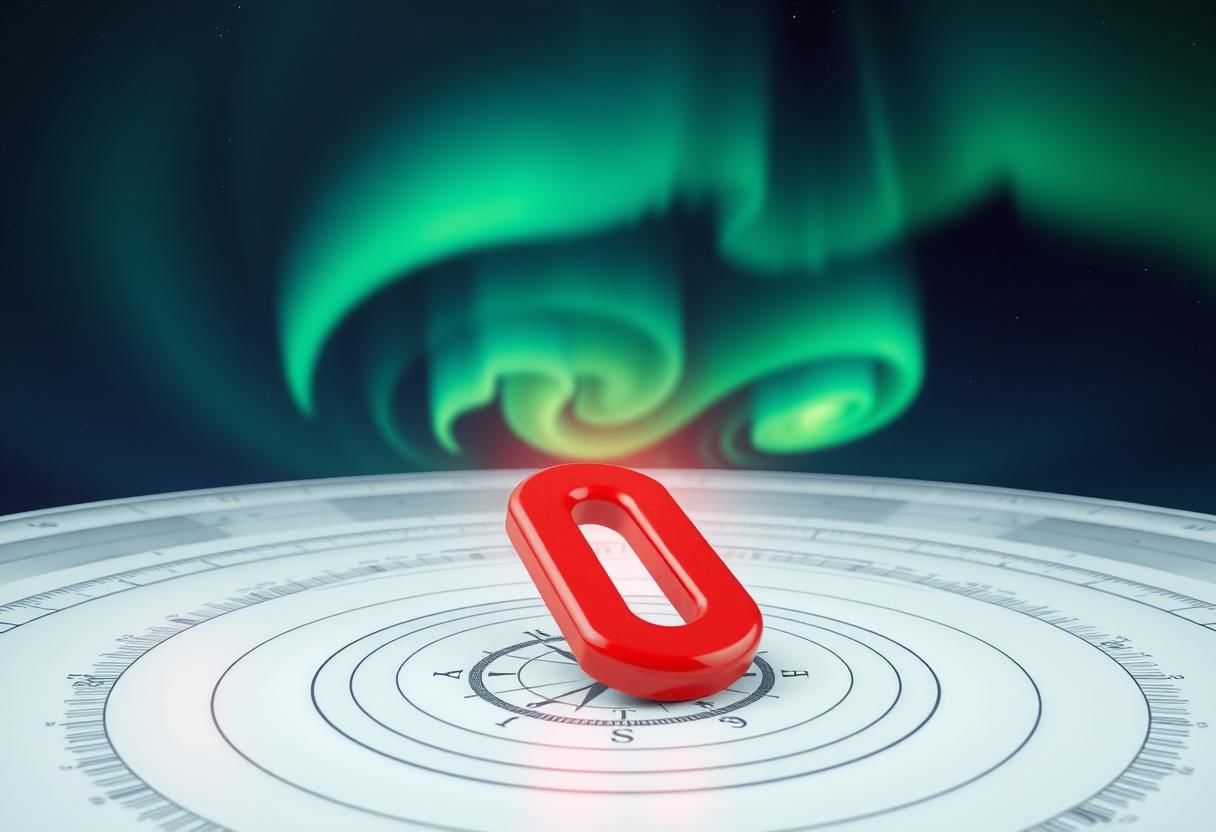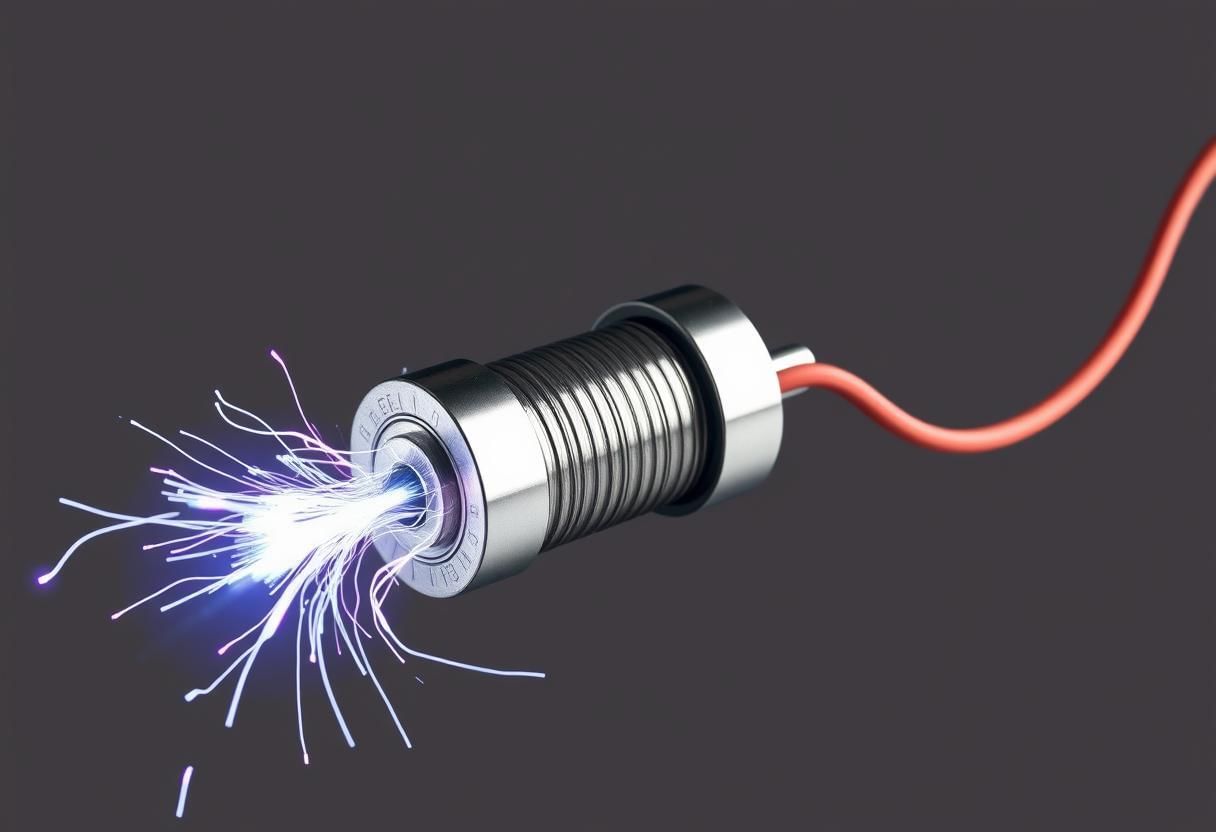Class 8 Exam > Class 8 Notes > Year 8 Science IGCSE (Cambridge) > Chapter Notes: Magnetism
Magnetism Chapter Notes | Year 8 Science IGCSE (Cambridge) - Class 8 PDF Download
Understanding Magnetic Fields
 Magnetic Attraction
Magnetic Attraction
- Magnetic Field : The region around a magnet where it can attract materials like iron, steel, nickel, and cobalt. For example, a magnet can attract steel paperclips.
- Poles of a Magnet : Magnets have two ends called poles, marked as north (N) and south (S) in diagrams. When a magnetic object, like a paperclip, gets close to a magnet’s pole, it is pulled towards it. This attraction stops when the object moves away.
- Strength of Magnetic Field : The magnetic field is strongest at the poles of the magnet. You can identify a magnetic field by observing the movement of a magnetic object or by using a compass.
- Compass : A compass has a magnetized needle that spins freely, aligning with the magnetic field and pointing in its direction. Many smartphones now have compass apps that use magnetic sensors to detect magnetic fields.
Magnetic Field Lines
- Magnetic Field Lines : To represent the magnetic field around a magnet, we use magnetic field lines that follow specific rules:
- Connecting Opposite Poles : Lines connect opposite poles, from north to south.
- Direction of Lines : Lines have arrows pointing from north (N) to south (S).
- No Crossing or Touching : Lines should not touch or cross each other.
- Bar Magnet : For a bar magnet, magnetic field lines create loops from the north pole to the south pole, with a concentration of lines at the poles.
- Horseshoe Magnet : In a horseshoe magnet, the lines form a U-shape, connecting the north and south poles closely.
- Strength Indication : The strength of the magnetic field is indicated by the closeness of the field lines; the field is strongest where the lines are nearest.
- Stronger vs. Weaker Magnets : A stronger magnet has lines that are closer together and extend further from the magnet than a weaker one.
- Direction for Compass Needle : The direction of the magnetic field lines shows which way a compass needle will point when placed in the field.
Interactions of Magnetic Fields
- Magnetic Field Interaction : When magnets are placed near each other, they can influence each other’s magnetic fields.
- Like Poles Repel : When like poles (north-north or south-south) are close, they repel each other.
- Opposite Poles Attract : When opposite poles (north-south) are near, they attract each other.
- Behavior Change : This interaction can alter the behavior of the magnetic fields involved.
How do Magnets Attract or Repel Each Other?
 Magnetic Wonders
Magnetic Wonders
- Magnets have different poles - a north pole and a south pole. The way two magnets interact depends on their poles.
- If you bring two north poles together, they will repel each other. Similarly, two south poles will also repel each other. However, if you bring a north pole and a south pole together, they will attract each other.
This attraction and repulsion happen because of the magnetic fields around the magnets. When opposite poles come close, their magnetic field lines align in the same direction, which causes them to attract. But when like poles come together, their field lines point in opposite directions, making them push away from each other.
How Did Ancient People Use Earth's Magnetism?
- 4,000 years ago, a Greek shepherd named Magnes discovered that iron nails in his shoes were drawn to lodestone, a naturally magnetic rock. This was one of the earliest observations of magnetism.
- The Chinese were among the first to make compasses using a lodestone needle. They floated the needle on water, and it would always point towards magnetic north, helping people find their way.
- Magnetic north is close to the geographic north pole, which is currently located in the Arctic Ocean, north of Alaska. The magnetic north pole moves slowly over time.
- The compass was a vital invention for navigation, allowing people to determine directions accurately in places like oceans and deserts where there were no landmarks.
- Even today, modern ships and airplanes use magnetic compasses for navigation, alongside advanced systems like satellite navigation (satnav), which does not rely on the Earth’s magnetic field.
- Some animals, such as migratory birds, have the ability to navigate long distances using the Earth’s magnetic field as a guide.
- The Earth itself acts like a giant bar magnet, with its magnetic field lines pointing towards the magnetic north pole. This is why the north pole of a compass needle, which is a small magnet, is attracted to the Earth’s magnetic north pole.
- Interestingly, the Earth’s magnetic north pole behaves like a magnetic south pole because it attracts the north pole of the compass needle.
- Magnetic north refers to the magnetic pole near the geographic north pole, while magnetic south is the pole near the geographic south pole. The geographic north and south poles are determined by the Earth’s spin axis.
- The Earth’s magnetic field also creates beautiful natural light displays called auroras near the north and south poles. These occur when solar particles interact with the stronger parts of the Earth’s magnetic field.
By understanding how the Earth’s magnetic field works, scientists are also looking into how this magnetic field was formed in the first place.
Introduction
 Electromagnetic Core
Electromagnetic Core
- Earth is made of magnetic materials.
- Earth’s magnetic field comes from its hot core, which is mostly iron and nickel.
- This core is very hot, and the movement of liquid iron there creates electric currents, producing the magnetic field.
- Sometimes, Earth’s magnetic field flips, changing where north and south are.
- This has happened many times in the past, with the last flip about 780,000 years ago.
Discovery of Earth’s Core and Magnetic Field
- Early ideas about Earth’s composition were incorrect.
- Scientists thought Earth was made of magnetic rocks, but these rocks would lose their magnetism due to the high temperatures inside Earth.
- However, Earth is not made of magnetic rocks.
- The magnetic field comes from the core, which is full of iron and some nickel, both of which are magnetic metals.
- The heat in the core creates the magnetic field, and the movement of liquid iron in the outer core causes the magnetic poles to move slowly and sometimes flip.
- The Earth’s magnetic north moves about 60 kilometers per year, which is why airport runways, marked by their direction to magnetic north, need to be updated regularly.
Properties of Magnetic Materials and Electromagnets
- A magnetic material is one that is attracted to a magnet. Examples include iron, nickel, cobalt, and steel, which contains a lot of iron. These materials can be magnetized, meaning they can become magnets themselves.
- Permanent magnets are made from magnetic materials and have a constant magnetic field that cannot be turned off. One way to create a magnet from a magnetic material is by using electricity, which produces an electromagnet.
Creation of an Electromagnet
- An electromagnet is made by wrapping a wire coil around a magnetic material, such as iron, which serves as the core. When an electric current passes through the coil, the core becomes magnetized, creating a magnetic field.
- When the current is stopped, the core loses most of its magnetism, allowing for control over the magnetic field. A basic electromagnet consists of a power source (like a battery), a wire coil, and an iron core (such as an iron nail).
Poles of an Electromagnet
Applications of Electromagnets
 Electromagnetic Innovation
Electromagnetic Innovation
- Electromagnets, like bar magnets, have a north and south pole. You can find these poles by using a magnetic compass or a bar magnet with known poles.
- Reversing the poles of an electromagnet is possible by changing the direction of the coil or the connections to the power supply.
Applications of Electromagnets
- Electromagnets are preferred over permanent magnets when a controllable magnetic field is required.
- In fire doors, electromagnets hold the door open. When a fire alarm activates, the electromagnet deactivates, allowing the door to close.
- MRI scanners in hospitals utilize strong electromagnets to produce detailed images of the human body.
- Scrapyards use electromagnets to sort scrap metal by attracting iron and steel while leaving non-magnetic metals like copper, aluminium, and zinc. The magnet can be turned off to release these metals.
- Some designs of toasters use electromagnets to hold the lever down, although many toasters rely on a spring mechanism.
- Electric bells use electromagnets to operate a hammer that strikes the bell. When the magnet is on, it completes the circuit, and when it turns off, the process repeats. This mechanism is commonly found in schools, fire alarms, and doorbells.
- Electric motors convert electrical energy into kinetic energy using electromagnets, which drives movement.
Strength of Electromagnets
- The strength of an electromagnet is influenced by several factors:
- The number of turns in the coil: More turns result in a stronger magnetic field.
- The amount of current flowing through the coil: Higher current leads to a stronger magnet.
- The type of core material: Ferromagnetic materials like iron increase the magnet's strength.
Factors Influencing Electromagnet Strength
 Electromagnetic Coil
Electromagnetic Coil
- Electromagnet strength is influenced by:
- Number of turns in the coil: More turns enhance strength.
- Core material : Iron and certain steels provide the best results.
- Current in the coil: Higher current leads to greater strength.
- Ways to boost strength include:
- Increasing coil turns while keeping current and core material steady.
- Boosting current (e.g., using more cells) while maintaining turns and core material.
- Using a soft iron core instead of steel, while keeping turns and current constant.
Understanding Soft Iron Cores
- Soft iron is easily magnetised and demagnetised, unlike softer materials such as modelling clay.
- In 2019, researchers developed an electromagnet 4,500 times stronger than a standard school bar magnet, using electricity comparable to three million electric lamps.
- The strength of an electromagnet is often gauged by the force it exerts on magnetic materials, typically measured by the number of magnetic objects, like paperclips, it can lift and hold.
The document Magnetism Chapter Notes | Year 8 Science IGCSE (Cambridge) - Class 8 is a part of the Class 8 Course Year 8 Science IGCSE (Cambridge).
All you need of Class 8 at this link: Class 8
|
3 videos|55 docs|9 tests
|
FAQs on Magnetism Chapter Notes - Year 8 Science IGCSE (Cambridge) - Class 8
| 1. What is the difference between a permanent magnet and an electromagnet? |  |
Ans. A permanent magnet is made from materials that are magnetized and maintain their magnetic properties without the need for an external power source. In contrast, an electromagnet is created by passing an electric current through a coil of wire, which generates a magnetic field. The magnetic field in an electromagnet can be turned on or off by controlling the electric current.
| 2. How do electromagnets work? |  |
Ans. Electromagnets work on the principle of electromagnetism. When an electric current flows through a wire coil, it generates a magnetic field around the coil. The strength of the electromagnet can be increased by increasing the amount of current, adding more coils of wire, or using a ferromagnetic core (like iron) inside the coil to enhance the magnetic field.
| 3. What are some common applications of electromagnets? |  |
Ans. Electromagnets are used in various applications, including electric motors, generators, magnetic locks, MRI machines, and in the operation of relays and switches. They are essential in devices that require the control of magnetic fields and are widely used in industrial machinery and electronic devices.
| 4. Can electromagnets lose their magnetism? |  |
Ans. Yes, electromagnets can lose their magnetism. When the electric current is turned off, the magnetic field disappears, and thus the electromagnet loses its magnetic properties. Additionally, if the electromagnet is subjected to extreme heat or physical damage, it may also lose its ability to generate a magnetic field.
| 5. What materials are commonly used to make electromagnets? |  |
Ans. Electromagnets are typically made using conductive materials such as copper or aluminum for the wire, and ferromagnetic materials such as iron, nickel, or cobalt for the core. These materials are chosen for their ability to conduct electricity and enhance magnetic fields, making the electromagnet more effective.
Related Searches
















